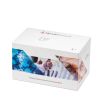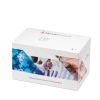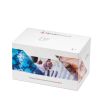I-FABP, Human, ELISA kit – 2 x 96 det. - HK406-02
Quantity
2 x 96 det.
Catalog #
HK406-02
1.223,00 €
Fatty acid-binding proteins (FABPs) are a class of cytoplasmic proteins that bind long chain fatty acids.
FABPs are small intracellular proteins (~13-14 kDa) with a high degree of tissue specificity. They are abundantly present in various cell types and play an important role in the intracellular utilization of fatty acids, transport and metabolism. There are at least nine distinct types of FABP, each showing a specific pattern of tissue expression. Due to its small size, FABP leaks rapidly out of ischemically damaged necrotic cells leading to a rise in serum levels.
Ischemically damaged tissues are characterized histologically by absence (or low presence) of FABP facilitating recognition of such areas. Intestinal FABP (I-FABP) is specifically localized in the epithelium cells of the small bowel. The I-FABP protein is derived from the human FABP2 gene. Normally, I-FABP is undetectable in serum. Many observations indicate that I-FABP is a useful biochemical marker for intestinal cell damage both in vivo and in vitro. Ischemically damaged cells are characterized histologically by absence (or low presence) of FABP facilitating recognition of areas of ischemically damaged cells.
FABPs are small intracellular proteins (~13-14 kDa) with a high degree of tissue specificity. They are abundantly present in various cell types and play an important role in the intracellular utilization of fatty acids, transport and metabolism. There are at least nine distinct types of FABP, each showing a specific pattern of tissue expression. Due to its small size, FABP leaks rapidly out of ischemically damaged necrotic cells leading to a rise in serum levels.
Ischemically damaged tissues are characterized histologically by absence (or low presence) of FABP facilitating recognition of such areas. Intestinal FABP (I-FABP) is specifically localized in the epithelium cells of the small bowel. The I-FABP protein is derived from the human FABP2 gene. Normally, I-FABP is undetectable in serum. Many observations indicate that I-FABP is a useful biochemical marker for intestinal cell damage both in vivo and in vitro. Ischemically damaged cells are characterized histologically by absence (or low presence) of FABP facilitating recognition of areas of ischemically damaged cells.
| Datasheet URL | https://www.hycultbiotech.com/wp-content/uploads/2022/06/HK406-1016.pdf |
|---|---|
| Quantity | 2x96det. |
| Quantity | 2 x 96 det. |
| Standard range | 47 to 3,000 pg/ml |
| Detection level | 47 pg/ml |
| Working volume | 100 µl/well |
| Species | human |
| Cross reactivity | Horse - No, Mouse - Yes, Pig - No, Rat - No |
| Alias | FABP2, FABPI |
| Application | The human I-FABP ELISA kit is to be used for the in vitro quantitative determination of human I-FABP in serum, plasma, urine and cell culture supernatant samples. |
| Principle | The human intestinal FABP ELISA is a ready-to-use solid-phase enzyme-linked immunosorbent assay based on the sandwich principle with a working time of 3½ hours. The efficient format of a plate with twelve disposable 8-well strips allows free choice of batch size for the assay. Samples and standards are incubated in microtiter wells coated with antibodies recognizing human I-FABP Biotinylated tracer antibody will bind to captured human I-FABP. Streptavidin-peroxidase conjugate will bind to the biotinylated tracer antibody. Streptavidin-peroxidase conjugate will react with the substrate, tetramethylbenzidine (TMB). The enzyme reaction is stopped by the addition of citric acid. The absorbance at 450 nm is measured with a spectrophotometer. A standard curve is obtained by plotting the absorbance (linear) versus the corresponding concentrations of the human I-FABP standards (log). The human I-FABP concentration of samples, which are run concurrently with the standards, can be determined from the standard curve. |
| Storage and stability | Product should be stored at 4 °C. Under recommended storage conditions, product is stable for at least six months. |
| Precautions | For research use only. Not for use in or on humans or animals or for diagnostics. It is the responsibility of the user to comply with all local/state and federal rules in the use of this product. Hycult Biotech is not responsible for any patent infringements that might result from the use or derivation of this product. |
| References | 1. Morariu, A et al; Dexamethasone: benefit and prejudice for patients undergoing on-pump coronary artery bypass grafting: a study on myocardial, pulmonary, renal, intestinal, and hepatic injury. Chest 2005, 128: 2677 2. Derikx, J et al; Detection of chemotherapy-induced enterocyte toxicity with circulating intestinal fatty acid binding protein. J Pediatr Hematol Oncol 2006, 28: 267 3. Cronk, D et al; Intestinal fatty acid binding protein (I-FABP) for the detection of strangulated mechanical small bowel obstruction. Curr Surg 2006, 63: 322 4. Derikx, P et al; Urine based detection of intestinal mucosal cell damage in neonates with suspected necrotising enterocolitis. Gut 2007, 56: 1473 5. Menskink, P et al; Transient postprandial ischemia is associated with increased intestinal fatty acid binding protein in patients with chronic gastrointestinal ischemia. European Journal of Gastroenterology & Hepatology 2009, 21:278 6. Aydemir, C et al; Serum intestinal fatty acid binding protein level for early diagnosis and prediction of severity of necrotizing enterocolitis. Early Human Development 2011, 87:659 7. Schroetter, H et al; H-FABP in Pre Capillary Pulmonary Hypertension: Comparison to Other Surrogate Parameters for Prediction of Severity and Outcome. Open Journal of Respiratory Diseases 2011, 1:1 8. Cheung, D et al; Vasopressin improves systemic hemodynamics without compromising mesenteric perfusion in the resuscitation of asphyxiated newborn piglets: a dose–response study. Intensive Care Med 2011 9. Braina, D et al; Cord blood intestinal fatty acid-binding protein (I-FABP) in full-term intrauterine growth restricted pregnancies. The Journal of Maternal-Fetal and Neonatal Medicine 2012 10. Van Bree, S et al; Systemic inflammation with enhanced brain activation contributes to more severe delay in postoperative ileus. Neurogastroenterology & Motility 2013 11. Chevalier, M et al; The Th17/Treg ratio, IL1RA and sCD14 levels in primary HIV infection predict the T-cell activation setpoint in the absence of systemic microbial translocation. Plos Pathogens 2013, 9 12. Moron, B et al; CYP3A4-catalyzed simvastatin metabolism as a non-invasive marker of small intestinal health in celiac disease. The American Journal of Gastroenterology 2013 13. Pelletier, J et al; Low-dose vasopressin improves cardiac function in newborn piglets with acute hypoxia-reoxygenation. Shock 2013 |
| Disease | Cardiology and metabolism, Gastroenterology |
| Application assays: | The human I-FABP ELISA kit is to be used for the in vitro quantitative determination of human I-FABP in serum, plasma, urine and cell culture supernatant samples. |
|---|---|
| Principle: | The human intestinal FABP ELISA is a ready-to-use solid-phase enzyme-linked immunosorbent assay based on the sandwich principle with a working time of 3½ hours. The efficient format of a plate with twelve disposable 8-well strips allows free choice of batch size for the assay. Samples and standards are incubated in microtiter wells coated with antibodies recognizing human I-FABP Biotinylated tracer antibody will bind to captured human I-FABP. Streptavidin-peroxidase conjugate will bind to the biotinylated tracer antibody. Streptavidin-peroxidase conjugate will react with the substrate, tetramethylbenzidine (TMB). The enzyme reaction is stopped by the addition of citric acid. The absorbance at 450 nm is measured with a spectrophotometer. A standard curve is obtained by plotting the absorbance (linear) versus the corresponding concentrations of the human I-FABP standards (log). The human I-FABP concentration of samples, which are run concurrently with the standards, can be determined from the standard curve. |






